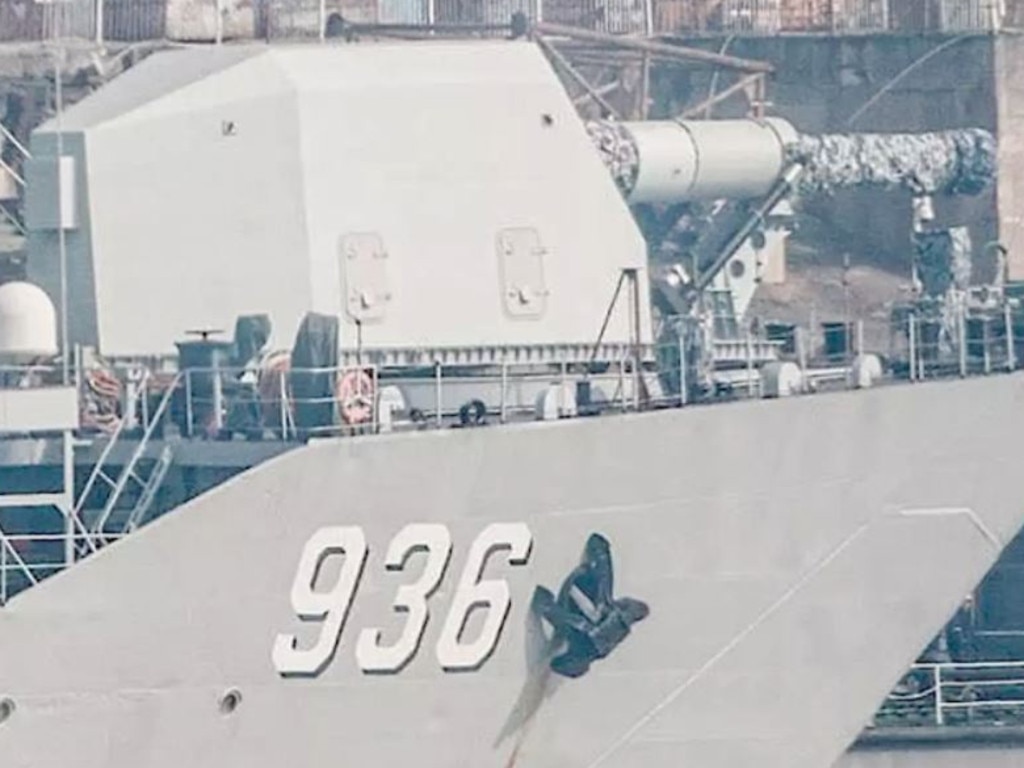China’s world first: Electromagnetic railgun goes to sea
China has beaten the world creating a new superweapon capable of firing at hypersonic speeds on a warship. Now it’s been spotted at sea.
The world was shocked when pictures began circulating early last year of a strange, large gun seemingly bolted to the bows of a Chinese amphibious assault ship.
It turned out to be the world’s first naval rail gun. Now it’s been pictured in operation.
A hazy image of the oddly-shaped ship with its oversized gun sailing in the open ocean has been released on China’s tightly controlled social media networks.
Long time no see, the railgun test ship is spotted undergoing sea trials these days. pic.twitter.com/WdxXkyYWrF
— dafeng cao (@dafengcao) December 29, 2018
It shows the vessel undergoing testing on the open ocean.
If true, it means Beijing has beaten the United States — and the world — to getting the next generation weapon into operational testing.

CHALLENGING CAPABILITY
The Type 072II Yuting-class tank landing ship Haiyangshan has been converted from its previous role to become an experimental testbed. This is likely because its open cargo bay is capable of holding the extensive array of batteries and generators necessary to power the next-generation weapon.
While still no warship, the cannon it carries is a fearsome sign of things to come.
What the hell is this? pic.twitter.com/sQDAsHd7A3
— dafeng cao (@dafengcao) January 31, 2018
It does away with the heat, pressure and residue of gunpowder-powered cannons.
Instead, it uses intense bursts of energy to build a focused magnetic field capable of flinging out cannon shells at many times the speed of sound.
This gives the gun much greater speed, range — and accuracy — than conventional cannons.
And it can be armed with guided shells capable of homing in on targets, and dodging defensive systems.
DELVE DEEPER: How hypersonic weapons will change the face of war
But it comes at a cost.
Instead of stacks of highly volatile propellant buried deep in the ship’s magazines, the gun needs massive amounts of on-demand electricity. This requires the generators to produce it, the batteries to hold it, and the capacitors to control it.
Don't need to worry about the power supply, note the three containers on deck, which could be the power station. pic.twitter.com/gTk4AgdvXT
— dafeng cao (@dafengcao) January 31, 2018
Which is why the old 119m long amphibious assault ship, once capable of carrying 10 tanks, is being used as a testbed.
The United States Navy has done a similar thing.
It has fitted a demonstration version of its Laser Weapon System (LaWS) aboard USS Ponce, a former amphibious transport dock ship now converted into a floating base and testbed.
While it has been at sea since 2014, the US Navy has so far not been successful in meeting its energy and fittings requirements aboard existing frontline warships.
NEW TECHNOLOGY
Weapons travelling at hypersonic speeds are the objective of a new arms race.
Beijing has also been proclaiming the success of its own hypersonic missile program, stating it gives them the power to drive the United States out of the South China Sea by sinking its aircraft carriers.
RELATED: Beijing’s devastating plan to force a US ‘surrender’
The electromagnetic rail gun is another incarnation of the advantages of extreme speed.
“Railguns use electromagnetic energy to attack targets and are considered an advanced technology that offers greater range and more lethality, while the cost is even cheaper than traditional guns,” the China Aerospace Science & Industry Corporation announced in 2015.
The railgun's 3D model made by 模人一架. pic.twitter.com/pNVG2PPwBr
— dafeng cao (@dafengcao) 3 February 2018
It achieves this by generating an electromagnetic field between two rails (thus the term rail-gun). A conductive sling, called an armature, catapults a warhead between the rails.
Such is the stress of acceleration, speed and friction that even the warheads have to be of completely new design and materials. While they can be ‘dumb’ like traditional unguided cannon shells, they can also be fitted with advanced avionics and sensors to guide them to their target.
As a result, the cost of each shot is estimated to be about $75,000 each.
But this is still significantly cheaper than a guided missile.

PATH OF PROGRESS
The first clues to the gun’s existence appeared in late January 2018 when the ship was pictured on the Yangtze River at the Wuchang Shipyard. In March, the state-controlled China Daily news service declared Beijing was “making notable achievements on advanced weapons, including sea tests of electromagnetic railguns”.
Reports reveal major achievements in Chinese naval weaponry, including sea tests of electromagnetic railguns, and noise-reduction of its nuclear submarines (Photo: IC) https://t.co/IjR5nrheYo pic.twitter.com/R9dNBYttV9
— Global Times (@globaltimesnews) 13 March 2018
The latest image appears to confirm the weapon is making developmental progress.
In June, a US naval intelligence report claimed the Chinese gun had proven capable of firing shells at a speed of 2.6km per second. It had been able to hit a target some 200km distant with a flight time of only 90 seconds.
The report predicted the rail gun would be ‘ready for war’ by 20205.
EXPLORE MORE: China’s rapid military evolution
The claims sound impressive. But they are yet to be verified.
But China and Russia’s determination to lead the world in this new weaponry cannot be denied.
The United States — and even Australia — have also been testing and developing hypersonic vehicles.
The US Navy has been testing its own rail gun (land based, for the moment) for about a decade. It wants a gun capable of firing up to 10 shots per minute, without the barrel-wear associated with chemical propellants.
But there have been problems. Power generation, the size and stability of its electronics and the resilience of its rails have delayed the weapon’s development.
Electromagnetic railguns were going to be fitted to the US Navy’s newest class of ultra-expensive, ultra-advanced Zumwalt destroyers. But even the more traditional 155mm Advanced Gun System cannons it has already been fitted with have proven too problematic — and expensive — to shoot. So the navy is considering replacing them with older, cheaper guns.
DELVE DEEPER: How hypersonic weapons will change the face of war
Only three such ships have been built. They were designed to generate 78 megawatts of electricity to power future weapons such as lasers or railguns.
Beijing says it has built its new Type 055 stealth destroyers to be capable of mounting its railguns.
“Though the test rail gun is not the final version of the hi-tech weapon, its size does fit the 055 destroyer, which would become an invincible vessel once equipped with electromagnetic weapons,” the People’s Daily Online declared in February.




